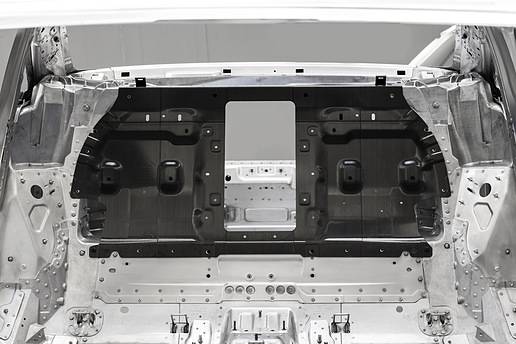 全新奥迪A8采用了CFRP材料的后面板和置物板,强度得到了进一步提升。
全新奥迪A8采用了CFRP材料的后面板和置物板,强度得到了进一步提升。 全新2018款奥迪A8共采用了14项先进连接工艺。
全新2018款奥迪A8共采用了14项先进连接工艺。 全新奥迪A8采用了镁材前撑杆。
全新奥迪A8采用了镁材前撑杆。 全新奥迪A8的新一代混合材料车架已经成型。
全新奥迪A8的新一代混合材料车架已经成型。 全新奥迪A8的车身结构材料主要以铝材为主。
全新奥迪A8的车身结构材料主要以铝材为主。
近日,奥迪(Audi)向外界展示了全新A8车型,包括该车型所采用的14项先进连接工艺,而奥迪主席Rupert Stadler和保时捷董事会主席Oliver Blume也发表声明,称两家公司也要“连接”起来,不过是从公司战略层面。
Stadler表示,“我们两家公司将集结最优秀的人才,联手迈向科技的美好未来。”而Blume补充道:“我们将集双方之所长,强强联手,在所有可能有所发展的领域进行合作。”
这意味着这两家汽车巨头将开始共享汽车架构、模块和组件,共同打造面向2025年的交通出行未来,而这一未来的基础将是电气化、数字化和自动驾驶技术。
尽管如此,两家公司仍将保持各自品牌的独立性,并不会失去各自的特质。Blume强调说,“保时捷永远都是保时捷。”
据了解,即将上市的新一代奥迪A8将继续沿用全铝车身的ASF(Audi Space-Frame)技术。因而Stadler也可以自信的表示,“奥迪也将永远是奥迪。”
具体来说,2018款奥迪A8将于今年夏天上市,预计将采用替代动力系统,并大量添加自动驾驶功能。这辆车的用材将继续以铝材为主,但也将同时采用钢、镁等常规材料。特别指出的是,为了显著降低重量、增强扭转刚度,新A8还采用了碳纤维增强聚合物(CFRP)的材料。奥迪公司表示,与现行版A8相比,2018款A8的扭转刚度提升了24%。
目前,奥迪的轻量化设计中心(Lightweight Design Center)大约有200名专家,其中25位专门研究纤维增强聚合物材料。为了抵消新型安全系统、油电混合动力系统等多种新技术所带来的重量增加,奥迪A8的减重之路一直没有停止。在此背景之下,尽管工程师已经竭尽全力,新奥迪A8的重量还是达到了282公斤(621磅),较上一代的231公斤(509磅)有所增加。
具体来说,A8的后舱壁及连接的置物架采用了CFRP材料,这也是A8车舱中最大的部件之一。奥迪工程师表示,该部件可以为整车提供大约33%的抗扭刚度。
奥迪同时表示,为了更好地吸收纵向和横向负载及相应的负载剪力,车辆采用了6到19层碳纤维层叠的设计,从而提供更好的负载性能。每层纤维可以以“任何希望的角度”组合在一起,而工程师几乎不用对这些纤维进行太多处理。
这也就是说,奥迪的这一新工艺可以实现直接使用碳纤维材料进行制造,从而免去了制造碳纤维板的中间步骤。此外,奥迪还将采用另一种新工艺,这个过程需要将纤维层板放在环氧树脂中浸润“几分钟”。尽管奥迪A8的车舱仍然采用了热成型的高强度钢,但铸铝节点及挤压型材等也占到了车身材料清单的58%。
工程师表示,新的热处理铸铝合金可以为车身提供超过230 MPa(33,359 psi)的抗拉强度,并在抗拉测试中表现出超过180 MPa(26,107 psi)的抗屈强度。这些合金型材的性能数据比之前有“明显提高”。
工程师表示,奥迪A8悬架支柱托的前支架连接采用了铝材,从而取得了28%的减重效果。铝制螺栓可用于将前支架直接固定在悬架支柱托顶部,从而提高抗扭刚度。从安全性能方面来看,在遇到正面碰撞时,车辆前部受到的力可以分散至三个缓冲区。
此外,奥迪A8的另一个重要变化是采用了14种不同的车身装配工艺,奥迪表示,在Neckarsulm工厂所生产的新款A8,所采用的铝材滚边技术、冲压铆合及远程激光焊接技术等均为首创。
有意思的是,这款A8的前、后车门边框采用了机器人滚压工艺柔性化包边技术,奥迪称这种设计可以方便乘客上下车,并优化驾驶员在A柱附近的视野。与2017款车型相比,这种车门边框设计可以增加36毫米(1.5英寸)的车内空间。
冲压铆合工艺(Grip punch riveting)可用于固定侧车架,配合机器人滚压工艺使用,共同为车辆提供结构性焊接支持。
奥迪的先进连接技术可以将车辆的铝制侧车架连接至热成型HSS钢材的B柱、车顶线及薄型法兰,这也让奥迪感到非常骄傲。
值得一提的是,奥迪A8还采用了远程激光焊接铝材。据悉,通过激光光束的精确定位,焊接边热开裂的风险会有“相当大”的降幅。此外,由于不再需要成本高昂的工艺控制工序,新工艺据称还可以在量产时节省95%的经常性生产成本。
目前,2018款奥迪A8的车架正在位于德国Neckasulm的新工厂中生产,该工厂的机器人生产设备大约有500台。
As Audi recently revealed details of the structural technology—including 14 advanced joining processes—of its all-new A8, Chairman Rupert Stadler and Porsche Chairman Oliver Blume were also making statements about joining, but on a strategic scale.
“The best brains of both companies will together set the technical course for the future,” said Stadler, and Blume added: “We will utilize the expertise of both companies and take advantage of synergies. We will co-operate wherever it makes sense.”
This means a shared vehicle strategy for architectures, modules and components to shape mobility up to 2025, that will rest on electrification, digitalization and autonomous driving.
But each company will ensure that its respective brands will each retain its individuality. “A Porsche is always a Porsche,” stressed Blume.
And with the upcoming A8, Stadler can rest easy that this Audi will always be an Audi, with its continued use of aluminum and space-frame technology, albeit complemented by other materials.
The model year 2018 car, to be launched this summer and designed to take alternative powertrains and extensive autonomous capability, will be aluminum intensive but will also use steel, magnesium and, significantly for weight saving and torsional rigidity, carbon-fiber reinforced polymer (CFRP). Claimed torsional rigidity is up 24% on the incumbent A8.
Currently, Audi’s Lightweight Design Center employs some 200 specialists, 25 of whom focus on fiber-reinforced polymers, as the battle continues to offset the increased weight of safety systems and expanding specifications plus provision for PHEV technology. Because of this – and despite all the engineers’ best efforts - the new A8’s BIW scales 282 kg (621 lb) against 231 kg (509 lb) for the previous generation.
CFRP is used for the rear panel and associated parcel shelf, the largest component in the occupant cell of the A8. It provides some 33% of the torsional rigidity for the whole car.
Detailing the material, Audi explains that to optimally absorb longitudinal and transverse loads and associated load-shearing forces, between six and 19 fiber layers are placed one above each other to deliver load optimization. The individual fiber layers comprise 50-mm-wide (2-in) tapes placed in a finished layered panel “with any desired fiber angle and minimal trimming of the fibers.”
The process obviates the need for an intermediary step of manufacturing entire sheets of carbon fiber. A further new process sees the layered panel wetted with epoxy resin and cured “within minutes.” Although high strength hot-formed steel components including tailored blanks are used for the occupant cell, aluminum cast nodes, extruded profiles and sheets, account for 58% of the A8’s body.
Detailing the performance of new heat-treated cast alloys, Audi engineers say these attain a tensile strength of more than 230 MPa (33,359 psi); the corresponding yield strength in the tensile test is over 180 MPa (26,107 psi). For the profile alloys, “significantly higher” values are delivered than those previously achieved.
Magnesium is used for a front brace linking the A8’s suspension turrets and provides a 28% weight saving, the engineers claim. Aluminum bolts are used to secure it to the strut tower domes to boost torsional rigidity. In terms of safety performance, a frontal collision would distribute resultant generated forces to three impact buffers in the front end.
A further significant aspect of technologies introduced in the A8’s build is the use of 14 different joining processes in body assembly. These embrace roller hemming, grip punch riveting, and remote laser welding of aluminum “which is being done in Neckarsulm for the first time anywhere in the world,” the company claims.
Interestingly, roller hemming is used round the front and rear door cutouts, described by Audi as aiding passenger accessibility while also improving driver field of view around the A-pillars. Space gain in the cutouts is put at 36 mm (1.5 in) compared to the 2017 car.
The use of grip punch riveting, that fixes the side wall frame in position, accompanies the roller hemming, which is supported by structural bonding.
Audi is particularly proud of its development and adaptation of these joining technologies, combining the aluminum side wall frame with the hot formed HSS sheets at the B-pillar, the roof line and the sills with their thin flanges.
Also significant is remote laser welding of aluminum. Exact positioning of the laser beam in relation to the welding edge is said to “considerably" reduce the risk of hot cracking. The new process is also said to bring a 95% saving on recurring costs in series production, as it eliminates the necessity of expensive process controls.
The car’s spaceframe is being built in a new facility at its Neckarsulm plant. Its robot population is about 500 machines.
Author: Stuart Birch
Source: SAE Automotive Engineering Magazine
等级
打分
- 2分
- 4分
- 6分
- 8分
- 10分
平均分
